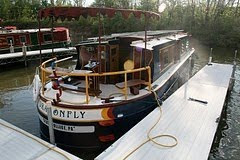 |
| Slow Moving vehicle |
 |
| Slow-moving vehicle |
(For non-gearheads: The solenoid is an essential part of the system that starts the engine.)
When you last saw our intrepid captain, the engine was NOT starting, and he was combing the
local auto parts stores for a replacement solenoid.
No solenoid to be had. After much clanging and banging in
the engine room--but with the engine still dead in the water—the Captain told the crew “cast
off!” and we departed Campbellford under electric power, only to run out of juice
four miles upstream.
With Dragonfly moored on a lock wall for the
night, the Captain descended into the engine room. No results that evening. More muttering and clanging next
morning. And, holy cow, the engine roared to life.
What did the trick?
Gearheads will soon find ALL the details in Bill’s blog, but long story
short (and with apologies if I got any of this wrong):
1. He cleaned
the contacts in the starter solenoid assembly (it’s the same general idea as
cleaning the contacts on your car battery).
2. He also
installed an automotive relay between the engine’s ignition switch and the
starter solenoid. (This bypassed a 20-year-old bundle of wires that were likely
corroded).
When frustrating things happen (like the engine
not starting) we constantly have to remind ourselves the express goal of this
trip was to learn about technology.
Obviously when your engine is on the fritz and there’s no handy marina
around and you HAVE to fix it yourself or else, you learn your way around an
engine. (I see a great future for Cap as a marine mechanic if the professor gig gets
old.)
Bill says he has especially learned, “The things you do while
you are trying to solve a problem can, in themselves, create NEW problems.”
For example: At one point, he took the starter solenoid off
completely. Well, there’s a pin
that goes from the starter solenoid into the starter. It activates a gear. An important gear. When Bill put the solenoid back on, he discovered
that little pin could fit into some
empty spaces in more than one way—and he couldn’t remember which way was the
RIGHT way. (He didn’t notice exactly how the pin was seated when he took the
solenoid off.)
Bill tried putting the pin back in six different ways and eventually reinstalled it correctly. The engine
roared to life . . . and then the
gauges showed the engine was overheating. (This is really bad.) There’s always something!
Hey, a new problem to solve! —and once again, a problem created in
the process of fixing things.
Turns out the engine was NOT overheating. Nope. In the process of his repair job Bill
had cleaned the connectors in the wiring harness. (Trust me, if you don’t know
what a wiring harness is, you don’t want to sit through the explanation). During the cleaning process, a little
bit of grit ended up in the wrong place and that screwed up the gauge.
Now that the engine is functioning, Bill is researching ways
to keep water weed off the propeller shaft.
Meanwhile Emily R. is accepting your bets: "Guess the total number of times Bill
goes swimming on this trip."
P.S. This morning our boat goes for a ride in the World’s Tallest Hydraulic Lift Lock (essentially, an elevator for boats) in Peterborough, Ontario. Stay tuned.





Thanks for the history lesson of the Peterborough Lift Lock. Very interesting. My wish for you both is no more engine trouble.
ReplyDeleteUnless Bill finds a solution to the water weed problem, he'll be swimming a lot more.
Probably a good thing he didn't whap it with a hammer!
ReplyDeleteOnce you're out of the locks and on Lake Huron, how are you going to get to Lake Michigan? A northern or southern route or a brave crossing of the Lake? Will you be coming down the east or west shore of Lake Mich (watch out for the Zebra mussels!).
Zebra mussels, they are here already on the Trent Severn! We see them clinging to the walls of the locks. When they are out of water, they like to squirt you!
ReplyDeleteAs for Bill and swimming, my colleague Emily R is taking bets on how often he goes in the drink this trip.